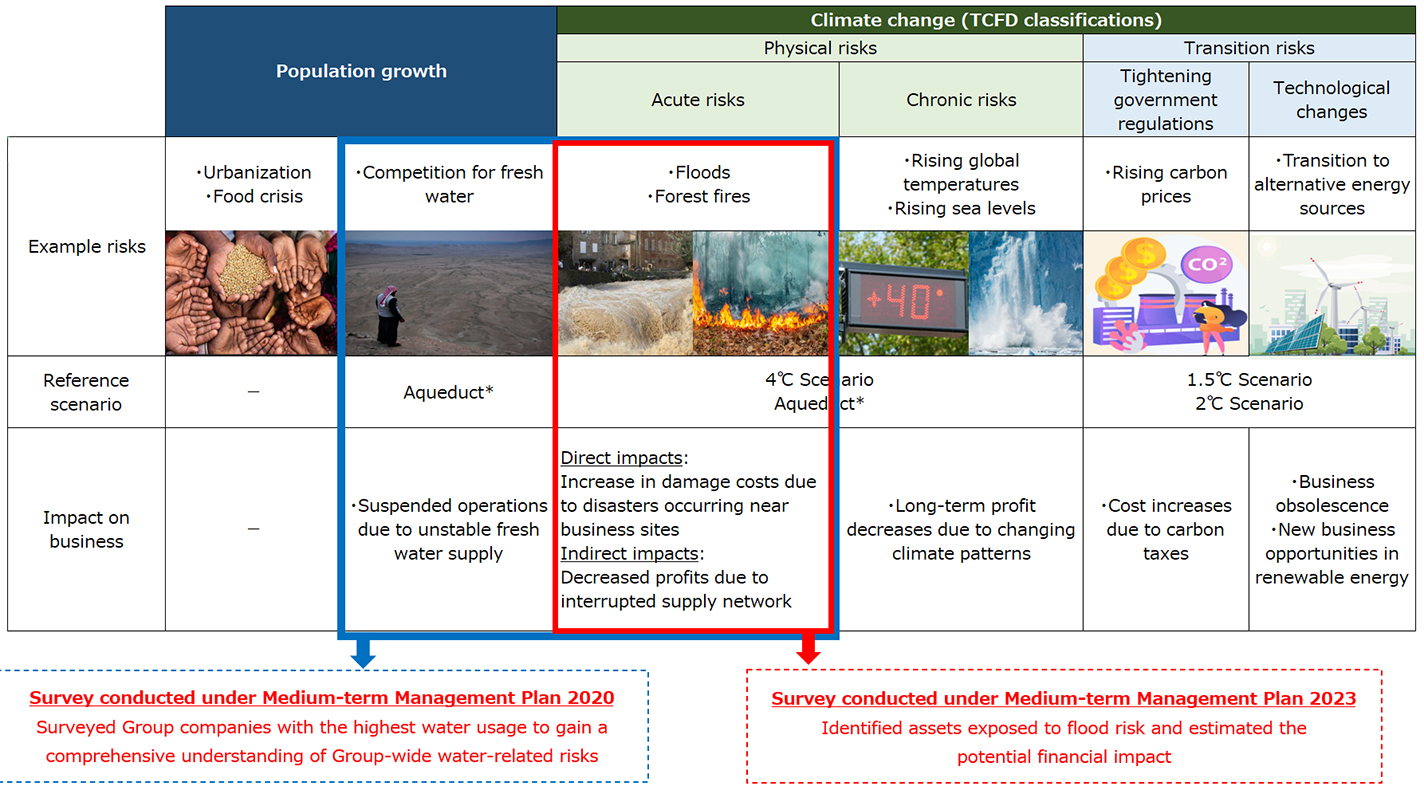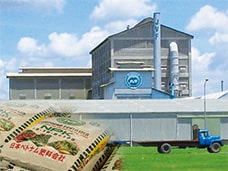Water Resources
1. Policy and Basic Approach
Water is an essential resource that supports all human activity, including corporate activities. However, saltwater makes up the majority of the earth’s water resources, and the amount of fresh water available for use by humans is extremely limited. Regions across the world are facing water resource problems such as water shortages brought on by population growth and increasing competition for available fresh water. Water resources are also unevenly distributed across countries and regions.
Furthermore, it is expected that local communities and businesses will increasingly be impacted moving forward due to the emergence of physical risks such as the changes in rainfall patterns caused by climate change.
Sojitz Group develops a wide range of business in a multitude of countries and regions around the world, and it therefore recognizes the importance of conservation and sustainable use of water resources. Sojitz has declared its commitment to “develop, use, and supply sustainable resources” as part of its Key Sustainability Issues (Materiality) and the Sojitz Group Environmental Policy promotes the recycling and the conservation of natural resources, including water.
Sojitz implements initiatives for reducing its water usage based on these policies and conducts regular checks to monitor the impact of water risks on Sojitz business. Sojitz also strives to provide solutions to water-related social issues through its business.
Read more
2. Goals and Targets
In addition to preparing for transition risks brought on by new regulations aimed at mitigating climate change, we are also planning ways to address physical risks in the event that climate change cannot be avoided and global warming continues to progress. To begin with, we are primarily focusing on water-related physical risks, such as damages to assets from floods and droughts. During Medium-term Management Plan 2020, we first surveyed the status of actions taken to address water stress by Sojitz Group’s top water users and confirmed that there were no problems with their on-site measures or with their systems for reporting to Sojitz headquarters. Moving forward, we will take steps to address other physical risks our its business. Sojitz is also engaged in initiatives for the conservation of natural resources, including water, and recycling.
Read more
3. Systems
3-1. Risk Management
3-1-1. Existing businesses
Sojitz Group uses Aqueduct, a tool for analyzing water risk developed by the World Resource Institute, to carefully analyze all water-related risks, including potential damages to assets caused by floods and droughts.
During Medium-term Management Plan 2020, we first surveyed the status of actions taken to address water stress by Sojitz Group’s top water users and confirmed that there were no problems with their on-site measures or with their systems for reporting to Sojitz headquarters.
Moving forward, Sojitz plans to conduct regular checks to monitor the impact of water risks on Sojitz business and disclose the results of quantitative surveys it conducts.
3-1-2. New Business
Prior to deliberating on new investment and loan projects, Sojitz requires the department applying for investment and loan approval to complete an “Environmental and Social Risk Checklist.” Using the checklist, the department confirms that they have conducted the required due diligence and taken all necessary measures to deal with potential environmental risks, such as impact to biodiversity; soil, groundwater, or water contamination; impact on water resources in water-stressed regions; and impact on indigenous peoples.
4. Initiatives
4-1. Water Risk Survey
Water is a natural resource that is essential for industry. However, water is unevenly distributed in regions around the world, and both excesses and shortages have the potential to impact supply chains and business activities. Specifically, Sojitz is exposed to the following types of water-related risk: 1) Risk of competition for water resources due to population growth and 2) Physical risks.
Risk of competition for water resources due to population growth:
Rising water demand caused by population growth can lead to water shortages, which could force businesses to suspend operations due to an inability to secure the necessary fresh water.
Physical risks:
The higher frequency of extreme weather phenomena brought on by climate change can lead to flooding and drought.
To comprehensively assess the potential impacts on our business operations, Sojitz regularly conducts water risk surveys using Aqueduct, a tool for analyzing water risk provided by the World Resources Institute.

4-1-1. Response to Water Scarcity
Approach
Our Group conducts an annual assessment based on the following approach:
1. Identification of Water Withdrawal Volumes
From among Group companies, those with relatively high water withdrawal volumes are identified, and their water use conditions are reviewed.
2. Identification of Material Risk Sectors
Sector-specific water-related risks are organized and identified with reference to internationally recognized questionnaires (such as CDP), NGO reports, and regulatory designations in each country.
3. Assessment Using the Water Risk Map “Aqueduct”
The Aqueduct water risk map is utilized to assess and update the status of water stress.
Based on the three criteria above, additional surveys are conducted for operating companies that meet any of the following conditions. This framework enables us to confirm site-level response measures and potential impacts on assets.
- Water withdrawal exceeds a defined threshold
- The company operates in a material risk sector
- Water stress is classified as Very High or High
Results
In the FY2025 assessment, no operating companies were identified as requiring additional surveys.
We will continue ongoing monitoring and further strengthen our water risk management framework.
4-1-2. Water Withdrawal in Water-Stressed Regions
Sojitz Group uses Aqueduct, a tool for analyzing water risk developed by the World Resource Institute. The following table details the total amount of water withdrawn by Sojitz Group business sites located in regions categorized as having “High” or “Extremely High” water stress according to the Aqueduct evaluation system. The sectors identified by external consultants as high-risk for water-related issues (agriculture, power generation, paper and pulp, chemicals, metals, oil refining, mining, food and beverage, textiles) are included in the scope of the survey.
| FY2021 | FY2022 | FY2023 | FY2024 | |
|---|---|---|---|---|
| Number of business sites located in water-stressed regions | 7 | 11 | 18 | 19 |
| Total amount of water withdrawal by business sites located in water-stressed regions (1000 cubic meters) |
192 | 174 | 209 | 278 |
4-1-3. Physical Risks
In addition to preparing for transition risks such as new regulations aimed at mitigating climate change, we are also planning ways to address physical risks in the event that climate change cannot be curbed, and global warming continues to progress. To begin with, we are examining the risks to our assets, primarily focusing on water-related risks such as floods and droughts.
Sojitz conducts regular surveys to confirm impacts on Sojitz’s businesses by utilizing the Aqueduct analysis tool for water risk assessment that references the 4-degree scenario (RCP8.5) provided by the World Resources Institute.
Under Medium-term Management Plan 2023, Sojitz is working to address physical risks classified by the TCFD framework. Sojitz measures the financial impacts for company assets identified as having potential flood-related risk, which is considered an acute physical risk.
Amount of damages to company assets (tangible fixed assets) in the event of a flood: JPY 29 billion
*Tangible fixed assets in the “Extremely High” and “High” category in the Aqueduct analysis tool as of end of March 2025.
4-2. Initiatives in Water-Stressed Regions
4-2-1. Entry into the Desalination Business
Sojitz has entered the natural-gas power and desalination business in the Emirate of Abu Dhabi, United Arab Emirates, a water-stressed region.
In May of 2021, Sojitz acquired a 20% stake in Mirfa International Power and Water Company (MIPCO), which operates the Mirfa Independent Water and Power Project in the Emirate of Abu Dhabi, United Arab Emirates. The company acquired all shares in MIPCO held by SHUAA Capital, a major asset management and investment firm in the Emirate of Dubai. Sojitz manages operations together with existing shareholders Abu Dhabi National Energy Company PJSC (TAQA), one of the largest integrated utilities companies in the EMEA region based in Abu Dhabi, along with ENGIE SA, a major French energy company with extensive experience in the development and operation of large-scale IPP/IWPP projects around the world.
The project consists of natural gas-fired power facilities which have a generation capacity of 1,600MW and desalination facilities which have a desalination capacity of 52.5 million imperial gallons per day. Sojitz and its partners own and operate the power and desalination plant. All electricity and water produced by the plant are sold to Emirates Water and Electricity Company under a 25-year long-term power and water purchase agreement. Sojitz seeks to provide a stable supply of electricity and water in Abu Dhabi where demand is increasing in response to economic development utilizing natural gas which is an environmentally friendly fossil fuel with a lower environmental burden of combustion compared to other types of fossil fuels used for thermal power plants.

Read more
4-3. Initiatives to Reduce Water Consumption
4-3-1. Initiatives within our Fertilizer Business
-
Sojitz Group subsidiary Japan Vietnam Fertilizer Co., Ltd. (JVF) produces compound chemical fertilizers using steam granulation. This manufacturing process pulverizes the raw materials, creating dust particles, but JVF has introduced equipment to control the amount of dust released into the atmosphere.
Additionally, the fertilizer mixing process uses water. The water used in this process is the same water used to collect the aforementioned dust particles. In this way, JVF recycles water within the facility to create a factory with zero water discharge.
These efforts to control air pollution and use water resources effectively have helped JVF achieve sustainable operations.
-

Production and sales of compound chemical fertilizer Business in Vietnam
(Japan Vietnam Fertilizer)
4-4. Cooperation with Our Stakeholders
Sojitz is a member of the Japan Foreign Trade Council’s* Sustainability Promotion Committee and is actively involved in the creation of a recycling-based society, including through management of water resources.
- Japan Foreign Trade Council is a group member of “KEIDANREN” (Japan Business Federation).
5. Performance
Number of incidents or violations by Sojitz Group concerning water intake and discharge
FY2024: 0 cases
